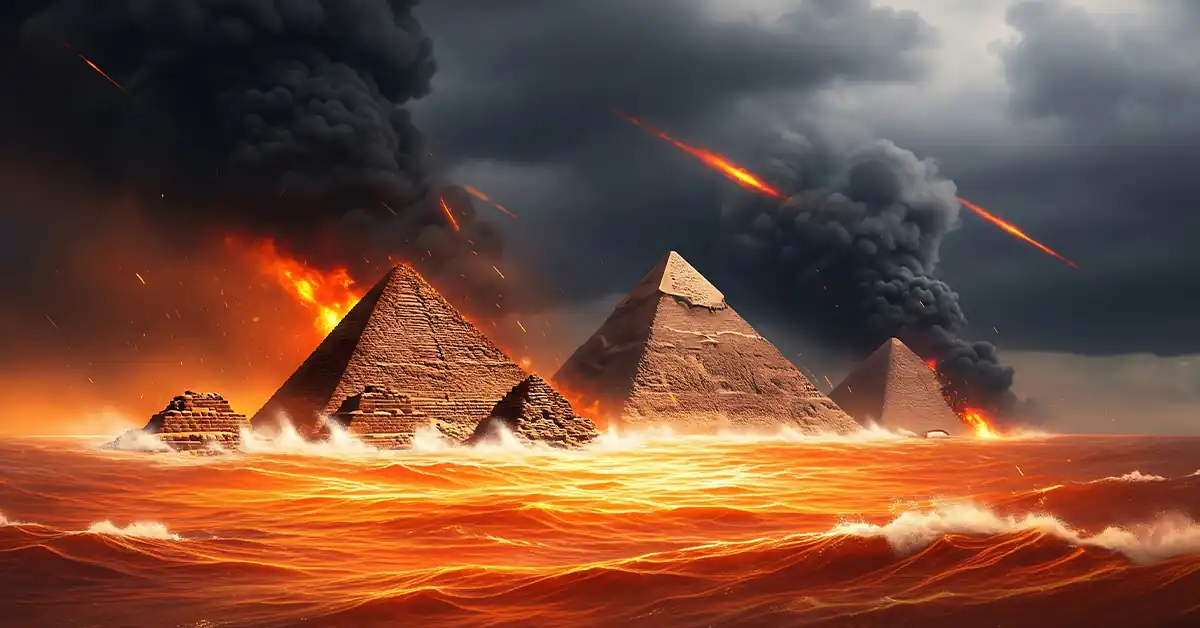Is the Lake of Fire Egyptian?

Is the Lake of Fire Egyptian?
Short answer: no. The biblical “lake of fire” is not an import from Egyptian religion. Ancient Egypt did speak of fiery lakes in the Duat (underworld), but those served very different purposes, often protective or purifying for the righteous and perilous for the wicked. Revelation’s lake of fire is a distinct, apocalyptic-Jewish image with a specific telos: the second death and the final defeat of Death itself. Read that again: not the eternal torture of God’s image-bearers, not their reduction to non-being, but the judgment that ends death.
This article frames the question under “fire,” contrasts universal reconciliation with the claims of Eternal Conscious Torment (ECT) and annihilationism, and clarifies where the imagery actually comes from.
What Revelation Actually Says
Revelation introduces the lake of fire at the climax of God’s judgment, not as a standalone geography of endless torment. Its key line defines the symbol: “And death and Hades were cast into the lake of fire. This is the second death.” Revelation 20:14. That sentence anchors the entire picture. If the lake is the “second death,” its primary object is Death itself.
Other scenes name the enemies cast in: the beast and false prophet (Revelation 19:20), the devil (Revelation 20:10), and “anyone not found written in the Book of Life” (Revelation 20:15). But John immediately turns from this vision to new-creation hope, where God dwells with humanity, wipes away tears, and makes all things new (Revelation 21–22). The narrative logic is transparent: God’s holy judgment removes what destroys, so that life may finally be unbroken.
What Egypt Actually Taught
Egyptian funerary texts (e.g., Book of the Dead; Amduat) describe lakes of flame guarded by divine beings. These lakes could destroy the enemies of cosmic order, yet, when approached with proper truth and alignment, could also purify or even empower the justified. In other words, Egyptian “lakes of fire” were elements within a moral cosmos, not a metaphysical torture chamber. They were not proclaimed as an eternal destination for ceaseless conscious agony.
Similarity of imagery does not equal sameness of theology. Fire as danger, judgment, purification, and protection is a shared ancient metaphor. But the biblical lake of fire is tethered to Israel’s prophetic grammar and Revelation’s eschatological storyline.
The Jewish–Biblical Roots of Fiery Judgment
Long before Revelation, Israel’s scriptures cast fire as God’s holy presence that both consumes evil and refines people.
– Isaiah’s judgment fire and Tophet imagery (Isaiah 30; 31; 33).
– Daniel’s courtroom vision where a river of fire issues from the Ancient of Days (Daniel 7).
– Malachi’s refiner’s fire for the sons of Levi (Malachi 3).
– John the Baptist’s “He will baptize you with the Holy Spirit and fire” (Matthew 3; Luke 3).
– Paul’s teaching that “each one’s work will become manifest… it will be revealed by fire” (1 Corinthians 3).
When Revelation gathers this lexicon into a single, climactic symbol, it is not borrowing Egypt’s afterlife policy; it is consummating Israel’s hope that God’s purifying justice will finally remove every corrupting power.
Why ECT Fails the Text (and the Gospel)
Eternal Conscious Torment (ECT) insists that God sustains the conscious suffering of His creatures without end. But Revelation defines the lake as the second death (Revelation 20:14). Death is defeated there. If the lake’s meaning is “unending life in agony,” then “death” no longer means death, and John’s own definition collapses. Worse, ECT fractures the gospel’s moral center: the justice that heals creation. The Judge who wipes every tear cannot also be the everlasting cause of every tear.
ECT also misses the narrative turn that follows the lake: the unveiling of the new heaven and new earth, the nations walking by the Lamb’s light, and the healing leaves of the tree for those nations (Revelation 21–22). New-creation flows out of judgment because judgment removes what ruins communion. That is the opposite of eternalized ruin.
Why Annihilationism Also Comes Up Short
Annihilationism sees the lake as literal extinction. It takes “death” seriously, good, but overlooks what the biblical fire consistently does in God’s hands: it purges and makes room for renewal. Scripture’s judgment fire is often surgical, not merely subtractive. The storyline after Revelation 20 is not a diminished cosmos; it is superabundant reconciliation in which the Lamb’s reign gathers the nations. Erasure of persons is not the horizon John shows us; the healing of peoples is.
The Lake of Fire as God’s Purifying Victory
If we let Revelation’s definition stand, the lake is where death dies and where evil’s structures face God’s unopposable holiness. That holiness burns away corruption and consummates new creation. It is fitting, then, to understand the symbol as the unveiled presence of God as consuming fire, “our God is a consuming fire.” Hebrews 12:29. The same presence that refines the faithful is the presence that dissolves the empire of death.
Malachi’s image explains the logic: “For He is like a refiner’s fire and like fullers’ soap.” Malachi 3:2. Fire does not exist to gratify divine cruelty; it serves divine love by ending what opposes love. Paul applies the same grammar to believers’ works: “the fire will test what sort of work each one has done.” 1 Corinthians 3:13. Fire reveals, proves, and purges. Revelation simply scales that truth to the last horizon.
“But What About the Strong Torment Language?”
Revelation is apocalyptic, saturated with symbols, hyperbole, and courtroom spectacle. Its torment language targets idolatrous systems and the spiritual powers behind them (beast, false prophet, the dragon). The point is not to enthrone suffering as God’s final word, but to announce the irreversible collapse of evil. When John defines the lake as “the second death,” he gives you the key: whatever else the imagery does, it terminates death’s regime so that life with God can be all in all.
Not Egyptian, And Not a Torture Chamber
So, is the lake of fire Egyptian? The term and its theological role in Revelation are not. Egypt’s fiery lakes are part of a different cosmology and a different endgame. Revelation’s lake is the divine verdict in which death is judged and ended. That is precisely why it refuses both errors: the cruelty of ECT and the finality of annihilationism. God’s judgment is neither endless sadism nor cosmic subtraction; it is holy love burning away all that kills, until only what is true remains.
Practical Takeaways
- Read Revelation on its own terms. Let “This is the second death” interpret the symbol. Revelation 20:14.
- Keep fire’s biblical function in view: reveal, refine, and remove what destroys.
- Let the story land where John lands, new creation, wiped tears, healed nations, rather than at a never-ending prison or a depopulated universe.
Conclusion
The lake of fire is not Egypt’s afterlife lake repackaged. It is Scripture’s final, concentrated image for God’s purifying victory, the judgment that ends death so that life may be unbroken. That is good news. It safeguards God’s character, secures creation’s future, and silences both the nightmare of eternal torment and the despair of non-being.
- 08/26/2025
- WRITE A COMMENT
Recent Posts
- The Eternal False Translation: How Aionios Was Corrupted Into Eternal
- The Rich Man and Lazarus
- Does Grace Last Forever?
- His Love Never Fails
- Love and Forgive Your Enemies
- His Mercy Endures Forever
- Scriptures That Teach Universal Reconciliation
- The Lesson of James, Peter and John
- Progressive Salvation is Biblical!
- The Gates Never Shut!


